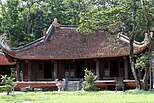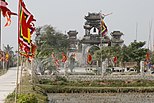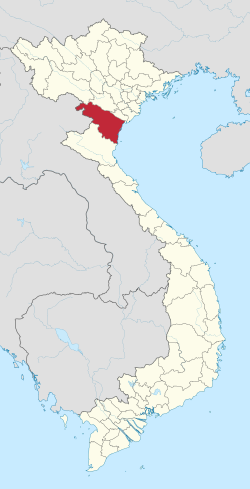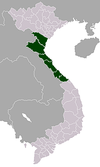Thanh Hóa Province
Thanh Hóa Province
Tỉnh Thanh Hóa | |
|---|---|
              Citadel of the Hồ Dynasty • Sông Mực Lake • Hải Hòa Beach • Trống Mái Mountain • Cẩm Lương fish stream • Mai An Tiêm Temple • Lam Kinh Temple • Phú Lệ Suspension bridge • Bà Triệu Temple • Dạ Lộc Temple • Lê Lợi Mausoleum • Lê Lợi Statue | |
 Seal | |
 Location of Thanh Hóa within Vietnam | |
 | |
| Coordinates: 20°0′N 105°30′E / 20.000°N 105.500°ECoordinates: 20°0′N 105°30′E / 20.000°N 105.500°E | |
| Country | |
| Region | North Central Coast |
| Capital (and Largest city) | Thanh Hóa |
| Government | |
| • People's Council Chair | Trịnh Văn Chiến |
| • People's Committee Chair | Nguyễn Đình Xứng |
| Area | |
| • Total | 11,129.5 km2 (4,297.1 sq mi) |
| Population (2019)[2] | |
| • Total | 3,640,128 |
| • Density | 330/km2 (850/sq mi) |
| Demographics | |
| • Ethnicities | Vietnamese, Mường, Thai, Thổ, Dao, and H'Mông |
| Time zone | UTC+7 (ICT) |
| Area codes | 237 |
| ISO 3166 code | VN-21 |
| Website | www |
Thanh Hóa (Vietnamese: [tʰajŋ̟ hwǎː] (![]() listen)) is a province in the North Central Coast region of Vietnam. This is a relatively large province, which ranks as fifth in area and as third in population among 63 central administrative subdivisions. Its capital and largest city is Thanh Hóa City. The province is widely called Xứ Thanh (The Land of Thanh).
listen)) is a province in the North Central Coast region of Vietnam. This is a relatively large province, which ranks as fifth in area and as third in population among 63 central administrative subdivisions. Its capital and largest city is Thanh Hóa City. The province is widely called Xứ Thanh (The Land of Thanh).
Human civilization has existed in Thanh Hóa for about 6,000 years ago, as one of the earliest centers of the ancient Vietnamese. Archaeological excavations have revealed that the first culture presented was the Đa Bút Culture, a culture located along the Sông Đáy river and the Sông Mã river.
Thanh Hóa is located in the middle of North Vietnam and North Central Coast as a transition in many aspects: geology, climate, administrative division and local culture. Thus, these factors show that is a province with many particular local habits and customs and cultures.
Thanh Hóa has two provincial cities, one district-level town and 24 rural districts with an area of 11,133.4 km2 and a population of approximate 3.6 million. Sầm Sơn city is a famous seaside resort situated 16 km from the Thanh Hóa city centre. Whilst, Bỉm Sơn township is a large industrial centre, especially cement. Nghi Sơn is a promising Economic zone, expected to be central of Thanh Hoa's Industrial with large Refinery Factory, Deepwater Seaport and many projects in progress. The province is also home of many ethnic groups, in which the most seven ethnicities are Kinh, Mường, Thái, H'Mông, Dao, Thổ, Khơ-mú.
Geography[]
Geographic position[]
The coordinate was accurately measured as 19°18'N - 20°40'N (from the southernmost point to northernmost point), 104°22'E - 106°05'E (from the westernmost point to easternmost point). It borders the following provinces: Sơn La, Hòa Bình, Ninh Bình, Nghệ An, it also neighbors Houaphanh province for 192 km boundary line furthermore.
Administrative divisions[]
Thanh Hóa is subdivided into 27 district-level sub-divisions:
- 23 rural districts:
- 2 district-level towns:
They are further subdivided into 28 commune-level towns (or townlets), 579 communes, and 30 wards.
Etymology[]
The province's name derives from Sino-Vietnamese 清化.
External links[]
| Wikimedia Commons has media related to Thanh Hoa. |
References[]
- Thanh Hóa Province
- North Central Coast
- Gulf of Tonkin
- Provinces of Vietnam

